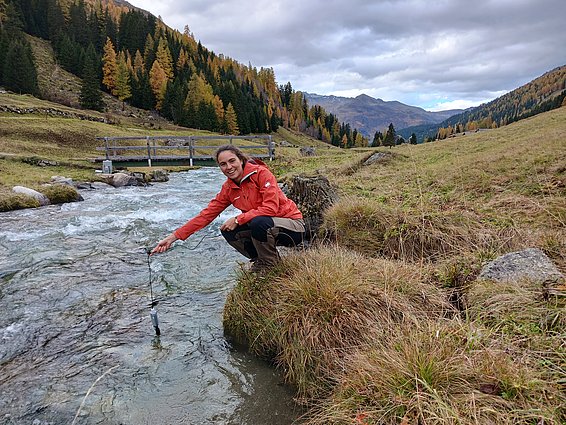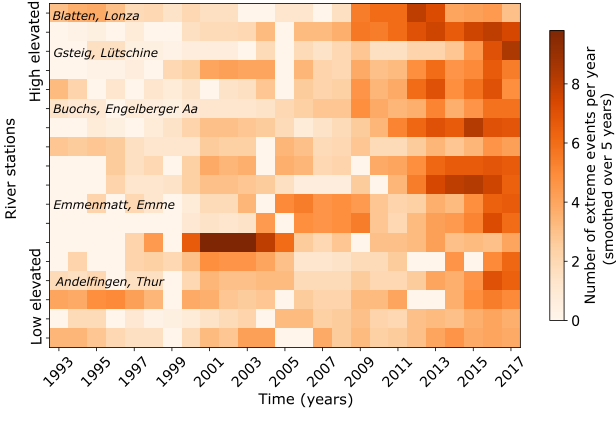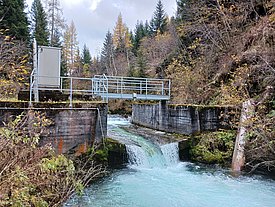SLF study shows: Water temperatures in European mountain rivers have been rising for decades. This is endangering water quality, fish, industry and the electricity production - and if the trend continues, ecological tipping points could be reached. Current forecasting models have so far ignored important causes of the rise in temperature and should be improved.
This text was automatically translated.
The water in mountain rivers and streams is getting warmer, with negative consequences for drinking water, industry, trout and many more. SLF hydrologist Amber van Hamel has been looking into why temperatures are getting warmer and how this is affecting almost 180 rivers in various mountain regions in Europe. She has been tracking both, the long-term average trend and individual extreme situations.
One thing is clear: the increasingly warmer air temperature due to climate change is also warming our rivers. But this is not the only important effect. Soil moisture, groundwater and meltwater also play a role in the occurrence of extreme water temperatures. However, current computer models only predict such events based on air temperature, explains van Hamel: "They are therefore not really suitable for predicting extreme water temperatures."
Reliable predictions of extreme water temperature are important. "Such extreme water temperatures can trigger ecological tipping points," emphasizes the researcher. For example, trout mortality increases at temperatures above 23 degrees Celsius. But it's not just the fish that are under threat - the entire biodiversity of the aquatic ecosystems is at risk. In addition, high temperatures can reduce the water quality, which could become a problem for the supply of clean drinking water to some communities. On top of that, industrial and utility companies may no longer be able to cool their production facilities and power plants sufficiently with river water, forcing them to reduce or even shut down operations.
For her study, van Hamel examined time series from 177 rivers in the Alps, the Pyrenees, the French Massif Central and the mountains of Scandinavia, including 35 from Switzerland such as the Emme, Rhone and the Dischma stream near Davos. "The average water temperature has increased by 0.38 degrees Celsius per decade over the past thirty years, which especially led to more extreme water temperatures at high altitudes in spring and summer," van Hamel found out. Rivers are nowadays around 1.1 degrees warmer than in 1994.
The highest temperatures were measured in the Pyrenees, in the Massif Central and in the Alps during summer. Some rivers are already regularly reaching 23 degrees Celsius and above. "The highest water temperature we observed in a single river was 28 degrees Celsius, in the Schwarzbach in Austria," says van Hamel. The waters in the Massif Central are all comparatively warm. In the Pyrenees and the Alps, on the other hand, the differences among rivers are great. This is due to the greater differences in altitude between the river basins.
In the Alps, van Hamel has observed an upward trend for all four seasons, with a particularly strong increase in summer. "If there’s less snow in winter because of climate change, there’ll be less cool meltwater reaching the rivers in spring and summer," she explains. In addition, there are more droughts. This reduces the moisture content of the soil and therefore less cold groundwater reaches the river system.
The situation is different for the extremes. Maximum water temperatures have hardly increased. "But the number of these events has increased significantly," van Hamel has observed - by seven days per decade, across all seasons. That is an increase of 3.8 percent per decade.
"The observed trends indicate that the probability of observing extreme water temperatures will most likely increase in the future," according to van Hamel. There is a growing need for accurate forecasts. She therefore recommends improving the existing models by taking into account other factors in addition to air temperature.
Contact ¶
Copyright ¶
WSL and SLF provide image and sound material free of charge for use in the context of press contributions in connection with this media release. The transfer of this material to image, sound and/or video databases and the sale of the material by third parties are not permitted.




